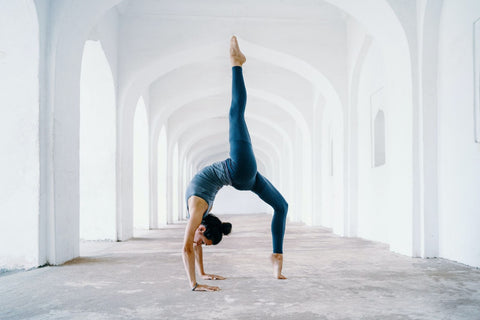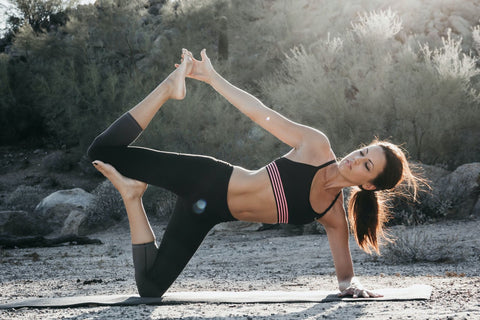
Yoga is meant to heal your body, help you feel centered, and enhance your fitness regime. However, yoga can cause serious injuries if not practiced with caution. Though yoga offers a wide range of health benefits, it is also a sport that uses the entire body in a wide range of movement, making it easier to get injured while practicing.
The National Center for Biotechnology Information (NCBI) reported that between 2001 to 2014, there were 29,590 yoga-related injuries seen in hospital emergency rooms. The injury rate was on the rise during this time period, especially as the practice has gained popularity in recent years. In fact, the number of American participants has nearly doubled from 5.1% (of adults) to 9.5% from 2007 to 2012.
In this article, we will explore the most common yoga injuries, broken down by body part, and give some tips and tricks to avoid these injuries and keep your body healthy, allowing you to continue practicing yoga to your heart’s content!

Hamstring Injuries
One of the most common injuries that come as a result of yoga is to one’s hamstrings. These occur due to forward folds, where you may force your body too far downward with straight legs. For that matter, forcing your legs straight in any pose, whether you’re standing, sitting, or lying down, can cause damage to your hamstring muscles. Sudden and jerky movements can also prompt hamstring injuries.
Hamstring tendonitis is prevalent in regular yoga practitioners. This particular ailment doesn’t happen in an instant, but instead happens gradually over time. This condition most commonly occurs in the hamstring muscle where it attaches to the sit bone, becoming more and more painful and apparent through tiny rips in the hamstring tendons over time.
It is actually quite simple to avoid these injuries. Simply not forcing the stretch or movement is the most effective method in keeping your hamstrings safe. To help avoid overstretching the muscle, focus merely on breathing and gradually lengthening your leg with each inhale, keeping the muscle engaged as you exhale.
Avoid using your hands to pull your body deeper into a forward fold, as this is where injury and tearing is likely to occur. Finally, keep your knees soft during inversions and listen when your body tells you it’s at its limit!

Elbow Injuries
Believe it or not, yoga is known to cause elbow pain, injuries, and conditions such as tennis elbow. This occurs as a result of hyper-extending your elbow, especially if you are bearing weight on this body part frequently. Poses such as side plank, reverse plank, wheel pose, downward dog, camel pose, and cobra pose can all cause significant damage to your elbow if you hyper-extend it in the process.
We realize that contracting tennis elbow through frequent yoga practice may seem a little odd, but it is certainly possible and is even common! Surefire signs that you have the ailment include pain primarily on the outside of your elbow, elbow pain while performing everyday tasks at home, and pain that is heightened when you are gripping, holding, or squeezing objects. Having trouble completely straightening and extending your arm when you first wake up is another tell-tale sign of the condition.
To avoid elbow strain and injuries when doing some of the common poses listed above, you should avoid putting weight on the elbow by keeping the muscles in your arms engaged. Try to externally rotate your shoulder joint, which puts the elbows into proper alignment, and avoid hyper-extension by keeping the elbows slightly bent. This is a simple trick that will go a long way!

Wrist Injuries
Much like elbow injuries attained through frequent yoga practice, wrist injuries are a result of placing too much weight on them during common poses like downward dog. You are especially at risk if your upper arms and forearms are not strengthened and toned. This is because inadequate strength in the underside of the forearm prevents the practitioner from pressing through their palm firmly enough to relieve the weight placed on the wrist.
The most effective way to avoid wrist injuries is to work on strengthening your arms before participating in poses that are likely to place a strain on your wrists. All it takes is some simple exercises to prime your arms. These include exercising with dumbbells, using resistance bands, and pilates boxing. The stronger your arms are, the less pressure will be placed on your wrists during yoga, and the more effective the poses will be, too!

Back Injuries
Unfortunately, back injuries are all too common in yoga. In fact, Shape reports that 46 percent of yoga injuries relate to the back and trunk areas of one’s body. Specifically, lower back pain and injuries are particularly common. Experts believe that oftentimes these injuries are attributed to the frequent rolling of the spine that occurs in yoga. This rounding requires the spine to move in the opposite way that it’s naturally intended to, which could lead to disc problems as well as back aches. These ailments are also caused by poses like forward fold and downward dog that could put a strain on the muscles in your back.
To avoid the back problems that frequently accompany regular yoga participation, start by avoiding certain poses that can amplify and perpetuate back pain. These include the camel pose, the lunge twist, the full wheel pose, the boat pose, and the shoulder stand.
Also, diminish your chances of back injury and pain during yoga by protecting and soothing your spine. As you are posing, try to avoid rounding your spine. To do this, consciously imagine lengthening your spine up and away from your hips to keep it better aligned. Then, use your core to support your spine in everything you do. Most people try to use their back as a prime mover, but if you move from your core, you will better prevent injuries.

Knee Injuries
Knee injuries seem to run rampant for yoga practitioners, and this in large part is related to a lack of flexibility. Especially in poses involving the legs or where legs are crossed, tightness in the hips can affect your knees, bringing them pain and tension. There are also poses that can lead to your knees falling out of proper alignment, leading to a strain or an eventual injury. This is especially common in poses like a high lunge, warrior one, triangle pose, and pigeon pose.
There are a few useful measures you can take to avoid obtaining a knee injury when hitting the mat. First, avoid spending long periods of time in poses that can cause hip tightness or discomfort, such as the full lotus pose or the cross-legged position. Next, when your knee is bent in any standing pose, avoid bending the knee over a 90 degree angle, as this puts weight on the knee joint.
The most important thing to remember when practicing yoga is to listen to your body and the signs it is sending you. Forcing your body past its natural limits, flexibility, and general comfort level can do more harm than good. Use the tips above and your own intuition to avoid incurring a yoga related injury so that you can keep saying “om” and enjoying your regular fitness and meditation regime!






